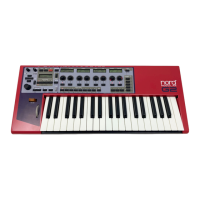11. Module reference: The Oscillator group NORD MODULAR G2 V1.1
Page 126
O
OO
O
S
SS
SC
CC
C
D
DD
D
This oscillator is similar to OscillatorC
but has less modulation inputs. See also
"Common Oscillator parameters”.
O
OO
O
S
SS
SC
CC
C
PM
PMPM
PM
The Phase Modulation Oscillator uses
the same basic technology for signal gen-
eration as the DX7. By constantly modu-
lating the phase of a signal, an “FM” type
of signal is generated. The frequency
bands track the basic pitch similar to the ‘FM Trk’ modulation in OscB and C described above but with
slightly different characteristics. The OscPH also features inputs for pitch modulation and sync. See also
"Common Oscillator parameters”.
O
OO
O
S
SS
SC
CC
C
S
SS
S
H
HH
HP
PP
P
A
AA
A
This Shape oscillator is able to generate a
vast variety of waveform shapes. There
are six basic waveforms to choose be-
tween and since you can transform and
modulate the shape of these waveforms,
it’s possible to generate very interesting
signals with very varying harmonic con-
tent. The principle for all Sinewave based signals is to start with a signal with a pure sinewave and then,
by gradually transforming the signal, adding more overtones and creating a more complex and rich signal.
The sonic result of changing the shape is similar to running a complex signal through a filter and changing
the cutoff frequency. The oscillator also has inputs for modulating pitch and frequency (FM) as well as
sync.

